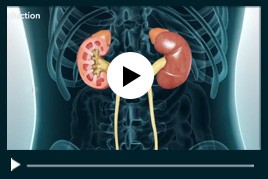Lithotripsy
Kidney stones are small, hard deposits that can develop in the kidneys. Lithotripsy, often referred to as Extracorporeal shock wave lithotripsy (ESWL), is the most common procedure for the management of kidney stones (renal lithiasis). It uses shock waves to break up stones that form in the kidney, bladder, or ureter to enable easy passage of the fragments out of the body within the urine. Most kidney stones are quite small and can be passed in urine. However larger stones are unable to pass through the ureters and can cause bleeding, kidney damage or urinary tract infections and may require more invasive treatment.
Indications
Lithotripsy is indicated in people with large kidney stones causing pain, urinary tract infection, bleeding, and renal damage.
Diagnosis
Your doctor usually arrives at a diagnosis of kidney stones based on your symptoms and medical history. Blood tests, urine tests, and other investigations may be ordered to confirm the diagnosis. Several diagnostic techniques such as X-ray, ultrasound, CT and intravenous urogram may also be used to identify the location of the kidney stones.
Intravenous urography is a test that involves injecting dye into a vein in your arm and taking X-rays, as the dye travels through your kidneys, to identify the presence of any stones.
Before the procedure
Prior to undergoing Lithotripsy, inform your doctor about any medications or supplements you are taking. Your physician may advise you to stop taking blood- thinning medications for a specified period of time. You will be instructed not to eat or drink anything for several hours before the procedure as well as what medications need to be taken on the day of the procedure. You may take your prescribed medications with a small sip of water.
Procedure
Prior to the procedure a mild sedative and pain medications are given. General anaesthesia is often used to keep you asleep and free of pain during the procedure. To prevent infection, your doctor will also prescribe you antibiotics.
Lithotripsy takes about 45 to 60 minutes to complete. During the procedure you will lie on a water-filled cushion. High-energy sound waves that are created outside of the body travel through the body until they hit the kidney stones and break them into tiny pieces. You may feel a tapping sensation on your skin as the shockwaves enter the body. A tube is inserted through your bladder or your back into your kidney to help drain urine from your kidneys until all the tiny fragments of stone pass out of your body. The tube may be inserted before or after the procedure.
After the procedure
You will be taken to the recovery room to be monitored for a couple hours after your procedure. Lithotripsy is usually an outpatient procedure where you are able to go home on the same day. You can usually resume regular activities within a day or two. You may experience pain when the stone fragments pass which occurs soon after treatment and may last for 4 to 8 weeks. Oral pain medications are prescribed to relieve pain. You will also be instructed to drink plenty of water to help clear the stone fragments out of your urinary system.
Risks and Complications
Lithotripsy is considered to be a relatively safe procedure but as with any medical procedure there are risks involved. Some risks associated with lithotripsy include:
- Bleeding in or around the kidney
- Kidney infection
- Failure to remove the stones requiring additional treatments
- Pain if a stone fragment blocks the flow of urine
- Kidney damage or a decrease in kidney function
- Ulcers may develop in your stomach or intestine

 Menu
Menu




